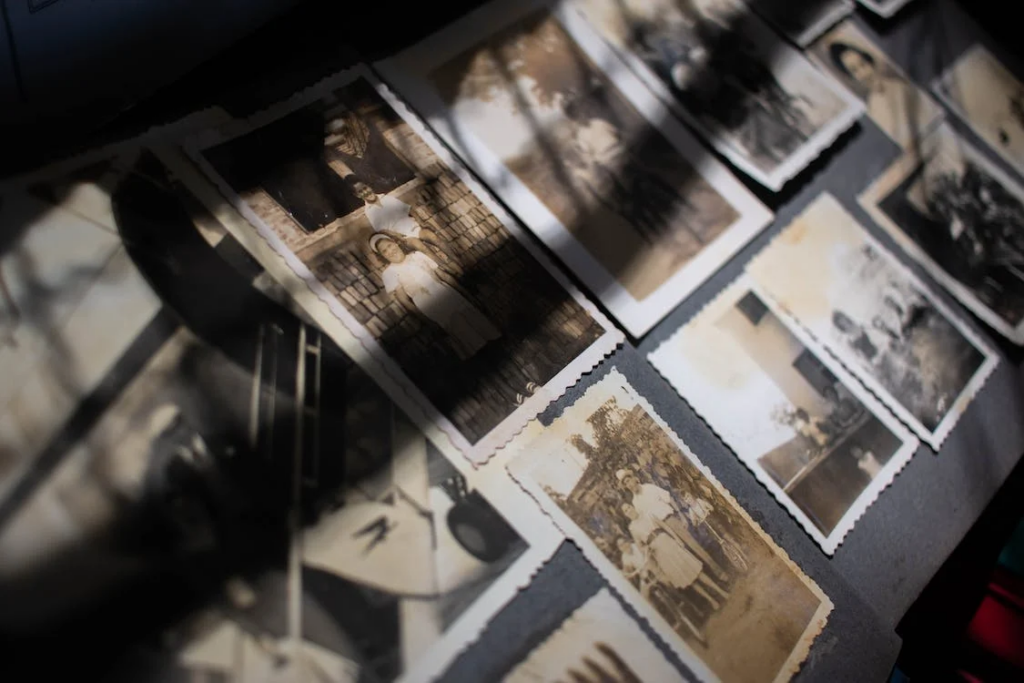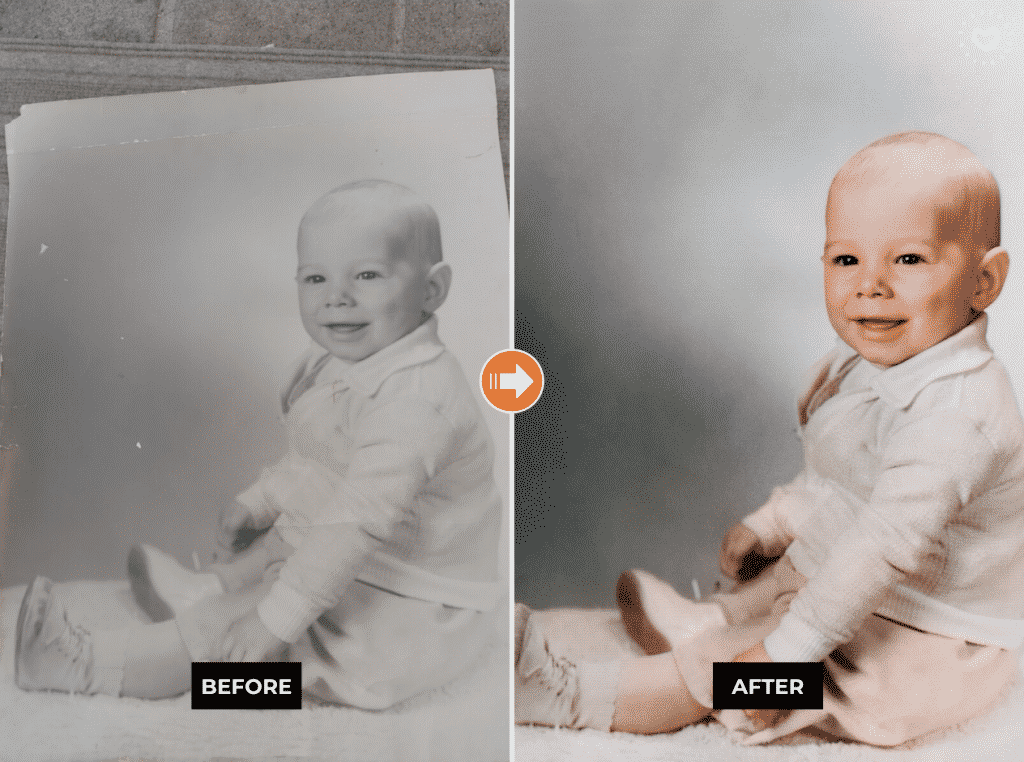Welcome to the enchanting world of image restoration, where memories are brought back to life and cherished moments are preserved for generations to come. Image restoration is an art form that combines the expertise of skilled professionals with advanced technology to breathe new life into old, damaged, or faded photographs. Through meticulous attention to detail and a deep understanding of photographic techniques, image restoration specialists like MemoryCherish work their magic to transform your most treasured moments into stunning visual masterpieces.
In this blog, we will take you on a journey through time, exploring the fascinating history of image restoration, how the process works, the emotional impact of restored images, and ultimately, why MemoryCherish is the perfect partner to help you preserve your precious memories. So, sit back and join us as we unravel the captivating magic of image restoration.
The History of Image Restoration
Origins and Early Techniques
The art of image restoration can be traced back to the early days of photography in the mid-19th century. As photographs became a popular way to capture memories, people began facing the challenge of preserving these fragile prints. In those days, photographic materials were prone to wear and tear, fading, and damage from environmental factors. Thus, the need for preservation and restoration techniques arose.
Initially, photographers and artists themselves would attempt to restore damaged images. They employed various methods, such as hand-coloring, retouching with pigments, or even painstakingly recreating entire portions of the image using brushes and paints. These early techniques were often time-consuming and required a high level of artistic skill.

Evolution of Restoration Methods Through the Years
As technology advanced, so did the techniques used in image restoration. The introduction of film photography in the late 19th and early 20th centuries led to the development of new methods for repairing and preserving images. Photographers started using airbrushes to retouch negatives and prints, allowing for more precise and subtle corrections.
By the mid-20th century, the advent of electronic imaging and computers revolutionized the field of image restoration. Digital tools allowed professionals to manipulate images with unprecedented precision and control. Software such as Adobe Photoshop, introduced in the late 1980s, provided powerful image editing capabilities, enabling restorers to perform complex tasks such as color correction, noise reduction, and image reconstruction.
Today, the field of image restoration has reached new heights, thanks to the ever-evolving digital technology. Modern restoration methods, such as artificial intelligence and machine learning algorithms, have made it possible to restore even the most severely damaged images with incredible accuracy. The combination of human expertise and cutting-edge technology has transformed image restoration into a sophisticated art form that continues to evolve and adapt to the changing needs of our treasured memories.
Get Your Photos Restored Today!
Discover the beauty of your old memories and get your photos restored today! Bring those moments back to life with our easy and convenient restoration service.
How Image Restoration Works
Basic Principles of Image Restoration
Image restoration is a process that involves the careful assessment, repair, and enhancement of damaged or deteriorated photographs. The primary goal is to restore the image as closely as possible to its original state while preserving its authenticity and integrity. This intricate process requires a deep understanding of photographic materials, techniques, and the specific types of damage that can occur over time.
The basic principles of image restoration involve identifying the nature and extent of the damage, selecting the most appropriate restoration method, and meticulously applying the chosen technique to achieve the desired results. Restorers must consider factors such as the type of photograph, its age, and the materials used in its creation, as these can significantly influence the restoration process and outcome.
Modern Tools and Technologies Used in the Process
Advancements in technology have greatly expanded the range of tools and techniques available to image restoration professionals. Some of the modern tools and technologies used in the process include:
- Digital Imaging Software: Programs like Adobe Photoshop, GIMP, and Affinity Photo provide powerful editing capabilities that enable restorers to perform tasks such as color correction, noise reduction, image reconstruction, and sharpening with remarkable precision.
- Artificial Intelligence (AI) and Machine Learning: These cutting-edge technologies are revolutionizing the field of image restoration by automating complex tasks and improving the accuracy and efficiency of the restoration process. AI-powered software can analyze damaged images, identify patterns, and generate predictions for the missing or damaged areas, resulting in more accurate and natural-looking restorations.
- High-Resolution Scanners: Modern scanners can capture incredibly detailed digital images of physical photographs, providing restorers with a high-quality canvas on which to work. These scanners can also be equipped with specialized features, such as infrared scanning, which allows for the detection and removal of dust and scratches without damaging the original image.
- 3D Printing and Modeling: In cases of severe physical damage, restorers may use 3D printing and modeling technologies to recreate missing or damaged elements of a photograph. This innovative approach can help restore the photograph’s original appearance while preserving its historical value.
By harnessing the power of these modern tools and technologies, image restoration professionals can perform their work with unprecedented precision and efficiency, ensuring that your cherished memories are preserved for generations to come.
Physical Restoration
Physical restoration encompasses a range of techniques used to repair and restore damaged physical photographs. These methods often require a combination of artistic skill, technical knowledge, and a keen eye for detail. Let’s explore some common techniques for restoring physical photographs and highlight a few examples of successful physical restoration projects.
Techniques for Restoring Physical Photographs
- Surface Cleaning: Gently removing dust, dirt, and grime from the surface of a photograph using specialized tools and cleaning agents. This process helps prevent further deterioration and prepares the photograph for additional restoration work.
- Tape and Adhesive Removal: Carefully removing tape, glue, or other adhesives that may have been applied to the photograph over time. This can be a delicate process, as improper removal can cause further damage to the image.
- Mending Tears and Rips: Using archival-quality materials and adhesives to repair tears, rips, or punctures in a photograph. This process often involves aligning the edges of the tear and securing them in place to ensure a seamless repair.
- Flattening Creases and Folds: Applying controlled heat, humidity, and pressure to gently flatten creased or folded photographs, returning them to their original flat state.
- Inpainting and Retouching: Filling in missing or damaged areas of a photograph using pigments, paints, or pencils that closely match the original image. This process requires a high level of artistic skill and knowledge of photographic materials.

Examples of Successful Physical Restoration Projects
- Restoration of Historical Portraits: In 2018, a team of restorers at the National Gallery of Ireland successfully restored a collection of 19th-century portraits by Irish artist Daniel Maclise. The project involved cleaning, repairing, and retouching the damaged surfaces of the paintings, bringing them back to their original glory.
- Revival of Vintage Family Photos: A restoration expert in New York City has made a name for herself by specializing in the repair and restoration of vintage family photographs. Using a combination of traditional and digital techniques, she has successfully restored countless heirloom photos, preserving precious memories for future generations.
- Conservation of War Photography: The Imperial War Museum in London has undertaken numerous projects to restore and conserve their vast collection of war photography. Skilled conservators use a range of physical restoration techniques to repair damage caused by time, exposure, and handling, ensuring that these historically significant images are preserved for posterity.
Through these techniques and successful projects, physical restoration plays a crucial role in preserving our photographic heritage and allowing us to connect with our past in a tangible, meaningful way.
Digital Restoration
Digital restoration is the process of using advanced software and technology to repair, enhance, and restore damaged or deteriorated photographs in a digital format. This approach offers several advantages over traditional physical restoration methods, making it an increasingly popular choice for preserving cherished memories. Let’s explore the benefits of digital restoration and examine some examples of successful digital restoration projects.
Advantages of Digital Restoration
- Non-Destructive Process: Unlike physical restoration, which involves working directly on the original photograph, digital restoration is performed on a high-resolution scan of the image. This means that the original photograph remains untouched and unaltered, reducing the risk of further damage.
- Precision and Control: Digital restoration software allows for incredibly precise and controlled adjustments to color, contrast, and detail. Restorers can zoom in on specific areas of an image, making even the tiniest corrections with ease.
- Efficiency and Speed: Digital tools enable restorers to work more quickly and efficiently than traditional methods, often resulting in faster turnaround times for clients.
- Versatility: Digital restoration techniques can be applied to a wide range of photographic formats, including prints, negatives, slides, and even historical processes like daguerreotypes and tintypes.
- Archival Storage and Sharing: Once an image has been digitally restored, it can be easily stored, shared, and reproduced without any loss of quality. This ensures that your precious memories are preserved for future generations to enjoy.
Get Your Photos Restored Today!
Discover the beauty of your old memories and get your photos restored today! Bring those moments back to life with our easy and convenient restoration service.
Examples of Successful Digital Restoration Projects
- NASA’s Lunar Orbiter Image Recovery Project: In 2008, a team of experts embarked on a mission to restore and digitize thousands of images taken by NASA’s Lunar Orbiter spacecraft in the 1960s. Using digital restoration techniques, they were able to recover and enhance these historic images, revealing unprecedented details of the lunar surface.
- Reviving Damaged Artwork: In 2013, a digital artist used advanced image editing software to restore a severely damaged painting by Dutch artist Jan van Huysum. The artist meticulously reconstructed missing sections of the painting, resulting in a stunning digital restoration that brought the artwork back to life.
- Preserving Cultural Heritage: The Digital Library of the Middle East, a collaborative project between several institutions, aims to digitize and restore millions of images, manuscripts, and artifacts from the region’s rich cultural heritage. By using digital restoration techniques, they are ensuring that these priceless treasures are preserved for future generations.

These examples demonstrate the power and potential of digital restoration as a means of preserving our visual history. Through the use of cutting-edge technology and skilled expertise, digital restoration enables us to protect and enjoy our most cherished memories for years to come.
The Emotional Impact of Restored Images
Connecting with Our Past Through Restored Images
Restored images hold immense emotional value, as they allow us to reconnect with our past and relive cherished memories. By breathing new life into old, damaged, or faded photographs, we can strengthen our ties to the people, places, and moments that have shaped our lives.
Whether it’s a portrait of a long-lost relative, a snapshot of a significant event, or a candid moment captured in time, restored images serve as tangible links to our personal history. They enable us to share our stories with future generations, ensuring that our experiences and connections are not lost to the passage of time.
Personal Stories of Clients Who’ve Experienced MemoryCherish’s Services
At MemoryCherish, we have had the privilege of helping countless clients experience the emotional impact of restored images. Here are a few of their personal stories:
- A Family Reunion Across Time: One client came to us with a box of old, damaged photographs from her grandparents’ wedding day. After restoring the images, she was able to surprise her family with a beautiful album of their ancestors’ special day, sparking a heartfelt conversation about their shared heritage and creating an unforgettable family reunion across generations.
- Honoring a Hero: A veteran approached us with a tattered photo of his father, who had served in World War II. We carefully restored the image, revealing the pride and courage in his father’s eyes. The restored photograph now holds a place of honor in the veteran’s home, serving as a constant reminder of his father’s bravery and sacrifice.
- Rekindling Childhood Memories: Another client brought us a faded photograph of herself and her childhood best friend, taken during a long-forgotten summer vacation. Through our restoration process, we were able to revive the vivid colors and details of that carefree moment. The restored image not only rekindled precious memories for our client but also inspired her to reconnect with her long-lost friend, rekindling a cherished friendship.
These stories illustrate the profound emotional impact that restored images can have on our lives. At MemoryCherish, we are honored to play a role in helping our clients preserve their precious memories and experience the magic of image restoration.
Tips for Preserving Your Cherished Memories
Taking steps to properly store, care for, and digitize your photographs can help ensure that your cherished memories remain intact for future generations. Here are some tips to help you preserve your precious images:
How to Properly Store and Care for Your Photos
- Choose the Right Environment: Store your photographs in a cool, dry, and dark environment. Avoid areas with high humidity, direct sunlight, or extreme temperature fluctuations, as these conditions can cause fading, discoloration, and other types of damage.
- Use Archival-Quality Materials: When storing or framing your photos, always use acid-free, lignin-free, and PVC-free materials. These archival-quality products will help prevent damage caused by chemicals and acids commonly found in non-archival materials.
- Handle with Care: Always handle your photographs with clean hands, preferably while wearing cotton gloves to avoid transferring oils or dirt onto the surface of the image. Hold photographs by their edges to minimize the risk of smudging or fingerprint damage.
- Avoid Stacking or Overcrowding: Store photographs flat, with acid-free tissue paper or interleaving sheets between each image to prevent sticking or scratching. Avoid stacking too many photographs together, as this can put pressure on the images and cause damage.
- Label with Care: If you choose to label your photographs, do so on the back using a soft pencil or an archival-quality pen. Avoid using ballpoint pens or markers, as they can bleed through the paper or cause indentations on the image.

Digitizing Your Memories for Future Generations
- Create High-Quality Scans: Use a high-resolution scanner to create digital copies of your photographs. Ensure that the scanner settings are optimized for the type of photograph and material being scanned (e.g., color, black and white, negative, or slide).
- Organize and Label Your Digital Files: Create a clear and consistent naming and filing system for your digital images. Include relevant information such as dates, locations, and names to make it easier to locate and identify your photographs in the future.
- Backup and Store Your Digital Files Safely: Regularly back up your digital image files to multiple storage devices or cloud-based services. This will help protect your memories against data loss due to hardware failure, accidental deletion, or other unforeseen events.
- Consider Professional Digitization Services: If you have a large collection of photographs or delicate historical images, consider using a professional digitization service like MemoryCherish. These experts have the equipment and expertise necessary to create high-quality digital reproductions of your cherished memories.
Why Choose MemoryCherish for Your Photo Restoration Needs
When it comes to entrusting your cherished memories to a photo restoration service, you want to ensure that you’re choosing a team of professionals who will treat your photographs with the care, skill, and attention they deserve. MemoryCherish is an excellent choice for your photo restoration needs, and here’s why:
Expertise and Experience of Our Team
At MemoryCherish, our team of skilled and dedicated restorers has years of experience in the field of photo restoration. We pride ourselves on staying up-to-date with the latest advancements in technology and techniques, ensuring that we provide top-quality results for our clients.
Our restorers possess a deep understanding of photographic materials and processes, enabling them to accurately assess and address various types of damage. They also have a keen eye for detail and a passion for preserving memories, which ensures that your photographs are treated with the utmost care and respect throughout the restoration process.

Array of Services Offered
MemoryCherish offers a wide range of services to cater to the diverse needs of our clients. Some of our key offerings include:
- Physical and Digital Restoration: We provide both physical and digital restoration services, allowing you to choose the approach that best suits your needs and preferences. Whether you require careful repairs to a physical print or a high-quality digital restoration, our team has the expertise to deliver exceptional results.
- Colorizing and Retouching: Our restorers are skilled at colorizing black-and-white images, as well as retouching and enhancing existing photographs. This allows us to breathe new life into faded, discolored, or otherwise compromised images, ensuring that your memories remain vibrant and vivid.
- Photo Digitization: Preserve your memories for future generations by utilizing our professional photo digitization services. We use high-resolution scanners and expert techniques to create accurate and detailed digital reproductions of your cherished photographs.
- Customized Solutions: At MemoryCherish, we understand that each photo restoration project is unique. That’s why we work closely with our clients to develop customized solutions tailored to their specific needs and preferences. From minor touch-ups to extensive reconstructions, our team is dedicated to delivering exceptional results that exceed your expectations.
By choosing MemoryCherish for your photo restoration needs, you can trust that your treasured memories are in the hands of a passionate and skilled team of professionals. We are committed to preserving your cherished moments with the care and attention they deserve, ensuring that your photographs remain a lasting testament to your personal history.
Conclusion
In summary, image restoration plays a crucial role in preserving our visual history and connecting us with our past. By skillfully repairing and revitalizing damaged or deteriorated photographs, we can ensure that our cherished memories remain intact for future generations to enjoy.
MemoryCherish’s team of experienced and dedicated restorers offers an array of services, including physical and digital restoration, colorization, retouching, and photo digitization. Our commitment to quality and personalized solutions ensures that your treasured photographs are treated with the care and attention they deserve.
Don’t let your valuable memories fade away. Take the first step towards preserving your past by trying MemoryCherish’s services today. Experience the emotional impact of restored images and share your stories with loved ones for years to come. Contact us now to learn more about how we can help you safeguard your precious memories.
FAQ
1. What is image restoration?
Image restoration is the process of repairing and revitalizing damaged or deteriorated photographs, either physically or digitally. This process enables us to preserve our cherished memories and maintain a connection with our past through visual images.
2. How does physical restoration work?
Physical restoration involves a range of techniques used to repair and restore damaged physical photographs. These methods often require a combination of artistic skill, technical knowledge, and a keen eye for detail. Techniques include surface cleaning, tape and adhesive removal, mending tears and rips, flattening creases and folds, and inpainting and retouching.
3. What is digital restoration?
Digital restoration is the process of using advanced software and technology to repair, enhance, and restore damaged or deteriorated photographs in a digital format. This approach offers several advantages over traditional physical restoration methods, including non-destructive processes, precision and control, efficiency and speed, versatility, and archival storage and sharing capabilities.
4. Why are restored images emotionally significant?
Restored images hold immense emotional value because they allow us to reconnect with our past and relive cherished memories. By breathing new life into old, damaged, or faded photographs, we can strengthen our ties to the people, places, and moments that have shaped our lives.
5. How can I preserve my cherished memories?
To properly store and care for your photographs, choose the right environment, use archival-quality materials, handle them with care, avoid stacking or overcrowding, and label them carefully. Digitizing your memories can also help ensure that they remain intact for future generations.
Get Your Photos Restored Today!
Discover the beauty of your old memories and get your photos restored today! Bring those moments back to life with our easy and convenient restoration service.





